Over the course of its history, Seville has been surrounded by walls. Starting out in Roman times, they have been continually reformed and rebuilt, expanding as the city grew over time. If you visit Seville you can still see vestiges of these ancient fortifications as you explore the city. The few segments that remain today date back to the Moorish Almoravid era. Much like the history of Seville, and the entire area that was once Al-Andalus, the walls of Seville can help us to understand the 800-year-long era of Muslim rule of the Iberian Peninsula and the so-called Christian Reconquista, or Reconquest, of Spain.
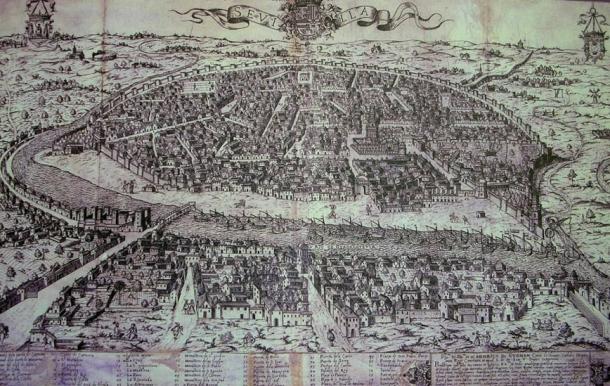
View of the walls of Seville in 1585. ( Public domain )
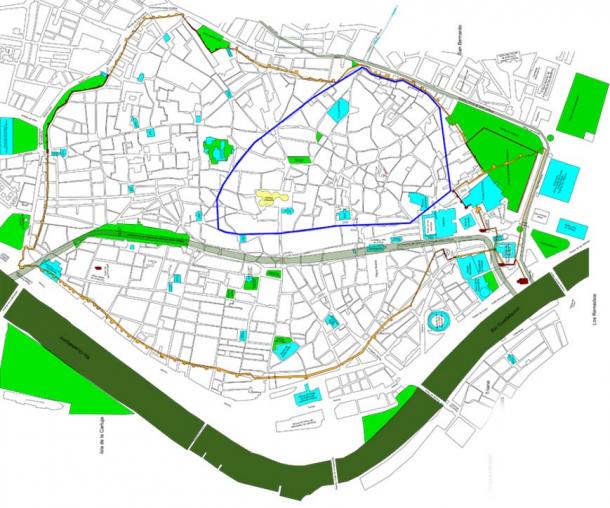
Map showing the walls of Seville under the Romans (in blue) and the walls built by the Moors from the 11 th century (in orange). (Álvaro C.E. / CC BY-SA 3.0 )
Who Built the Walls of Seville?
Legend has it that Hercules founded the city of Seville as a trading post, hence the Alameda de Hércules , a garden mall pedestrian area now known for its buzzing night scene. Under the rule of the Romans, the city was known as Hispal, and later Hispalsis, and it morphed into an important market metropolis. During the time of Julius Caesar , the city was surrounded by walls sometime in the 60s BC. These Roman defensive walls replaced the existing stockades from previous eras. Under his adoptive son Augustus, these walls were expanded as the city continued to grow.
In 844 a Viking fleet navigating up the Guadalquivir River reached Seville, by then under the control of the Moors. The Vikings managed to take the city. In the process they damaged the Seville walls, which were reconstructed more than once over the years before Abu al-Qasim, known as the first king of Seville, decided to rebuild the walls of Seville again.
So began a project that lasted throughout the 11th and 12th centuries to protect the city from the vengeful Christians. The defended city center of Seville was hugely expanded, with the prime objective being security and protection. Excavations conducted in 1985 have shown that the origins of this expanded defensive structure was Almoravid and Almohad, both Berber Muslim dynasties who controlled huge swaths of the Iberian Peninsula during this time.
These spectacular fortified walls of Seville comprised a whopping 166 watchtowers and several main gates and postigos or secondary gates running along seven kilometers (4.34 miles) of wall. These were the awe-inspiring barriers which would have faced Ferdinand III of Castile during his complex siege of Seville which lasted for over a year. On the 23rd November 1248, the Moorish forces conceded defeat and were given a month to abandon the city. Ferdinand entered Seville, through one of the gates of the walls of Seville, which was later renamed to Puerta Real , or Royal Gate, in memory of this moment.
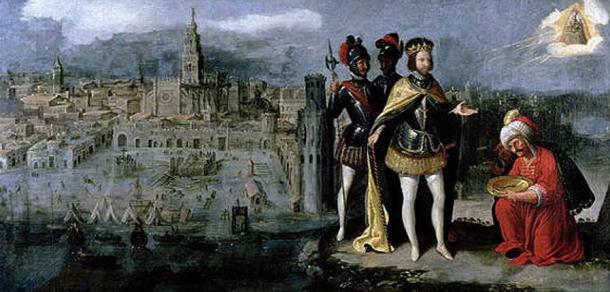
Painting depicting the capture of Seville by Ferdinand III after a long siege. In the background, the walls of Seville. ( Public domain )
Decline of the Walls of Seville: What’s Left Today?
In the 19 th century, with the development of more modern weaponry, the concept of a defensive wall became unnecessary and the structure was adapted for alternative uses. One of these was that of protection from frequent floods, a type of containment system whereby the gates would be closed tight and walls waterproofed. Another was that of using the gates for customs control, for the collection of taxes. They were even used for controlling disease during epidemics.
In the interest of progress and expansion of the city, the fashionable urban modernization of the time, the municipal government ordered the destruction of the gates of the city in the 1800s, particularly after 1868, making way for wide avenues and new construction. As urban planning trends changed, the walls of Seville were then designated a Spanish Property of Cultural Interest in 1908, and in 1984 the decision was taken to restore some of the remnants which had survived.
At the most northerly section of the walls of Seville, lies the Puerta de la Macarena , or the Gate of Macarena. Between here and the Puerta de Córdoba , the oldest gate which has been preserved, passersby can see the most well-preserved section of the Moorish walls of Seville. Between the two there are several towers, in particular the Torre Blanca . Local residents have campaigned for many years to rehabilitate this area as a tourist destination, and in 2020 the local government announced they would start work to clean, conserve and open the intramural section to the public for the first time.
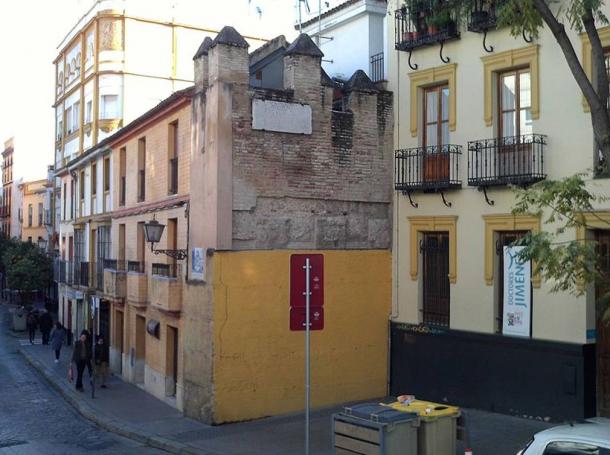
A small section of the Puerta Real as it exists today. (CarlosVdeHabsburgo / CC BY-SA 4.0 )
Remaining Remnants of History Hidden Throughout Seville
Nevertheless, José García-Tapial, one of the architects who conducted restoration on the wall in the 1980s, has explained that the complete defensive wall was far bigger than what we can see today. “I’m convinced that between 70% to 75% of the wall still exists embedded between buildings that have been built up against and attached to both sides of it,” he highlights in Diario de Sevilla .
Scribbler In Seville has blogged about the “random sections” which are still in evidence around her beloved Seville. These include the Postigo de Aceite located near the Cathedral, the Postigo del Alcazar in callejón de la Judería, or even a “small chunk” of wall on calle Alfonso marked by a plaque commemorating the location of the aforementioned Puerta Real , which she “walked past for years before noticing it.” The memory of these prominent features in the landscape has remained in the locations where gates once stood, with locals still referring to the names of the gates of Seville when talking about the areas, such as with Puerta de la Carne or Puerta de Jerez .
Other iconic architectural features that have survived the passage of time include the hexagonal-shaped Tower of Abd al-Aziz, Torre Blanca on calle Macarena and the octagonal Torre de la Plata on calle Santander. The latter was originally linked via a stretch of wall to the famous Torre del Oro , which can still be found on the banks of the Guadalquivir river. While this section of the walls of Seville was demolished, the dodecagonal Torre de Oro , or Tower of Gold, is now an important landmark in modern-day Seville. This strategic tower was once an anchor for an enormous chain which was used to block the river. The anchor point on the other side of the river no longer exists.
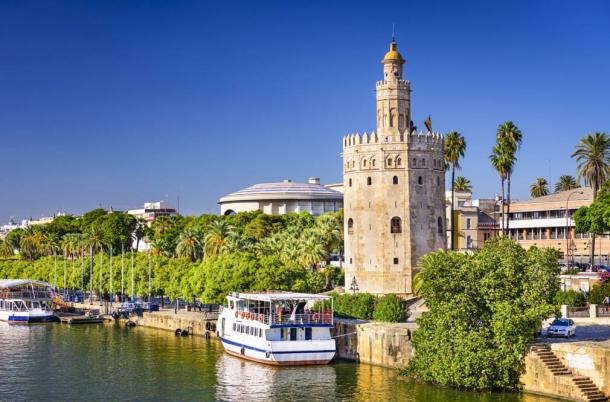
The Torre de Oro, on the banks of the River Guadalquivir in Seville, was once a tower connected to the rest of the defensive city center by the walls of Seville. ( SeanPavonePhoto / Adobe Stock)
Visiting the Walls of Seville
If you’re looking to explore the remaining sections of the ancient walls of Seville, the most well-preserved section can be visited on calle Resolana in the northern section of the historic city center. Here visitors can view a 400-meter-long (1,312 ft) wall that runs between the Puerta de Córdoba and Puerta de la Macarena .
Top image: A stretch of the ancient walls of Seville are still visible along calle Resolana, between the Gate of Macarena and the Gate of Córdoba. Source: joserpizarro / Adobe Stock
By Cecilia Bogaard
Related posts:
Views: 0
 RSS Feed
RSS Feed

















 May 8th, 2021
May 8th, 2021  Awake Goy
Awake Goy  Posted in
Posted in  Tags:
Tags: 
















